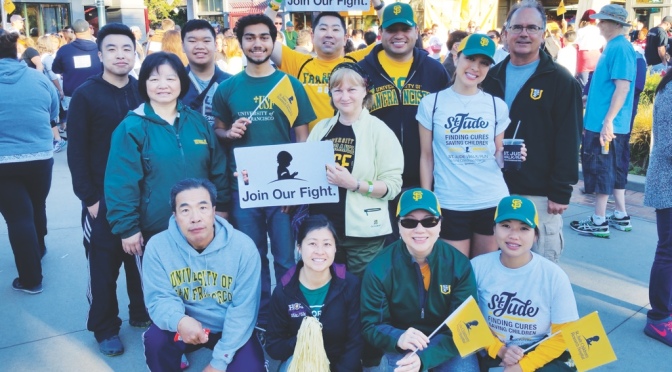Brian Healy
Staff Writer
September is Childhood Cancer Awareness Month, and to recognize the occasion, St. Jude Children’s Research Hospital has organized 58 Walk/Run Fundraisers in communities nationwide. The San Francisco fundraiser took place this past Saturday at the San Francisco Zoo. A group of USF alumni, faculty, parents, and current students took part, raising funds and doing their part to help end childhood cancer.
The walk is actually the finale of the teams’ long fundraising process. After a team forms, they set up a fundraising page. Then team captains and established team members recruit family and friends to join the process, and, finally, the teams set out to raise money for the kids of St. Jude. At the walk, teams and their members join other supporters in celebrating their fundraising efforts.
“All the people you see here are walking with a purpose to end childhood cancer,” said Amanda Salapong, regional development representative for St. Jude’s and one of the main organizers of the fundraiser, “It’s a powerful thing to see so many people, who have worked so hard to raise money for the kids, come together. It makes everyone realize that we’re all one large team that worked together in trying to defeat a common enemy.”
Laura Carney, a USF alumni and a member of the administrative staff for the Army R.O.T.C program, led the USF team. According to Carney, this year was the first time USF members had their own team in the walk. Carney believes that events such as this one have the ability to bring the USF community closer through activism and philanthropy. “The fundraiser establishes camaraderie among all the USF community,” said Carney, who promised to “build a tradition that we can keep rolling on in future years.”
The group, which consisted of 17 people, had to set a second donation target of $2,000 after they easily surpassed their initial monetary goal of $1,500. By the time of the event, a total of $2,170 was donated by or through USF’s group, with close to 50 different people donating. Carney, however, feels confident that even more donations will be coming through. “We may have close to $2,500 with the way things are going. Money is still rolling in, people are still collecting cash and checks, and some people are even mailing them in or turning them in today,” said Carney.
The San Francisco version of the St. Jude Walk to End Childhood Cancer was able to pull in $230,000 in donations, most coming from teams just like the one from USF, and from people like School of Management student Samantha Oliva who was able to fundraise $950 dollars in a week on her own.
The team attributes much of their success to a difficult experience with a previous fundraising effort. Team member Sam Matsunaga, a university employee at the ITS Help Desk, spoke about the problems they encountered. “Unfortunately, this year’s AIDS Walk fundraiser was not so successful because there was about only ten people from USF who attended,” said Matsunaga. When it came time to register for the St. Jude Walk to End Childhood Cancer, Matsunaga says that Carney rallied the troops with the purpose of making up for the disappointing turnout for the AIDS Walk.
The improvement effort was not without its own obstacles. “In our first meeting, only four people showed up. We had no idea how to make this thing successful, but with the help of Go Team members and an advisor from St. Jude’s, we knew where to start and get ourselves out there,” said Matsunaga. After the team made promotional flyers, sent out emails asking for contributions, set up informational booths at the University Center and at Lone Mountain, and set up a Facebook page, they eventually began to receive the attention and donations they needed.
Donations are used to cover approximately 75 percent of St. Jude’s budget costs and create treatments that have helped push the overall childhood cancer survival rate from 20 percent to 80 percent since St. Jude opened more than 50 years ago. Donations also cover the cost of treatment, travel, housing, and food for patients and their families.
Salapong hopes that participants remember what St. Jude’s does for children and families in unfortunate situations, so that they may spread awareness of the hospital’s important role. “We have patient families here who are able to spread the St. Jude message, and people are already well-informed by what they learned while fundraising. It would be great if supporters could continue to let people know about the way St. Jude is trying to understand, treat, and hopefully defeat childhood cancer,” said Salapong.
The message was well-received by USF team member Roberto Montoya. “It’s important to make people more aware about what’s going on. These types of events pull in interested people who will look into what St. Jude does for children with cancer, and then they will find a way to help out,” he said.
Even with so many contributions, the goal of the event, $275,000, was not met. However, donors can still help the event reach its goal by making a contribution at www.walkrun.stjude.org/USF_Dons
Photo courtesy of Sam Matsunaga


Correction: I was able to fundraise $950 in two days, not one week. Imagine how much we would surpass our fundraising goal had other USF students and I joined the team fours weeks prior!
Great article, Brian!
Four*